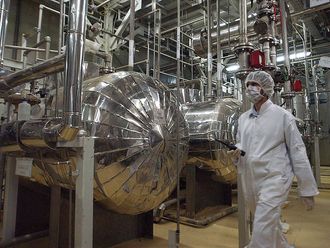London: Ancient Egyptians may have been concocting complex and effective mixtures to preserve their dead as far back as 4300BC, new evidence suggests.
That’s almost 2,000 years before prehistoric Europeans started work on Stonehenge, and about 1,500 years earlier than the art of mummification in Egypt was believed to have begun.
“The science is very powerful and straightforward,” said Stephen Buckley, a chemical archaeologist at the University of York in England. “It shows clearly that Egyptians in prehistoric times were playing around quite sophisticatedly with embalming agents.”
It had been generally accepted by Egyptologists that mummification did not start in Egypt until the time of the Old Kingdom (around 2500BC), and that it didn’t reach its height until the Middle Kingdom (2000-1600 BC).
The remains of people who lived even earlier had been found, but archaeologists assumed they were preserved naturally from burial in the hot and dry desert sand and not through any deliberate mummification by their survivors.
The new evidence, published in the journal PLOS One, comes from funerary textile remnants collected from two of the earliest known Egyptian cemeteries that date to 4500BC.
These shards of cloth, some with ancient bits of bone and skin still attached to them, have been part of the collection of the Bolton Museum in northern England since the 1930s.
After hearing reports about early-Egyptian methods of wrapping bodies, Jana Jones, lead author of the paper and a textile expert at Macquarie University in Sydney, Australia, went to examine the linens for herself under a microscope. It looked to her like they had been coated in resin, but without chemical evidence she couldn’t be sure.
So she called in Buckley, who has a background in organic chemistry and an interest in Egyptology. Using a series of techniques including gas chromatography-mass spectrometry and sequential thermal desorption/pyrolysis, he took small samples of the textiles and separated them into their individual chemical components.
From this process he was able to determine that the linens were covered in a mixture that included pine resin, animal fat, aromatic plant extracts and natural petroleum.
“These were complex recipes with a number of different ingredients mixed together and applied to the linen,” Buckley said. “And they are essentially the same recipe that was used 3,000 years later.”
Buckley should know — his doctoral thesis was on identifying the ingredients of resin used in mummification during the classical Egyptian period.
The chemical analysis revealed other interesting results. Some of the ingredients in the embalming mixture came from as far away as modern-day Turkey, which suggests the ancient Egyptians were more mobile than previously believed. He also found evidence of a chemical that comes from sea sponges on some of the oldest pieces of cloth. But on more recent samples, the chemical fingerprint left by the sponge was gone.
“These were once people of the sea, and they probably noticed the sponge’s ability to regenerate,” he said. “But over time this particular chemical signature disappears, which corresponds with a move away from exploiting marine resources, as they focus on the Nile valley and become more terrestrial.”
It should be noted that the full mummification process was not in place even by 3500BC. For example, it does not appear that these early Egyptians removed the organs from their dead, as they would later. Also, in the earliest samples, only the hands and the head were wrapped in linen.
Buckley said he wants to look at slightly later burial sites to get a better idea of how Egyptian civilization developed over time.
“In the past it was almost like these people were not allowed to be seen as sophisticated,” he said. “Now, because of the science, I hope there will be a big reassessment.”
— Los Angeles Times












